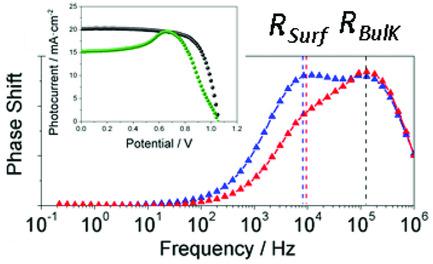当前位置:
X-MOL 学术
›
Adv. Mater. Interfaces
›
论文详情
Our official English website, www.x-mol.net, welcomes your
feedback! (Note: you will need to create a separate account there.)
The Role of Surface Recombination on the Performance of Perovskite Solar Cells: Effect of Morphology and Crystalline Phase of TiO2 Contact
Advanced Materials Interfaces ( IF 4.3 ) Pub Date : 2018-10-08 , DOI: 10.1002/admi.201801076 Jesús Idígoras 1 , Lidia Contreras-Bernal 1 , James M. Cave 2 , Nicola E. Courtier 3 , Ángel Barranco 4 , Ana Borras 4 , Juan R. Sánchez-Valencia 4 , Juan A. Anta 1 , Alison B. Walker 2
Advanced Materials Interfaces ( IF 4.3 ) Pub Date : 2018-10-08 , DOI: 10.1002/admi.201801076 Jesús Idígoras 1 , Lidia Contreras-Bernal 1 , James M. Cave 2 , Nicola E. Courtier 3 , Ángel Barranco 4 , Ana Borras 4 , Juan R. Sánchez-Valencia 4 , Juan A. Anta 1 , Alison B. Walker 2
Affiliation

|
Herein, the preparation of 1D TiO2 nanocolumnar films grown by plasma‐enhanced chemical vapor deposition is reported as the electron selective layer (ESL) for perovskite solar devices. The impact of the ESL architecture (1D and 3D morphologies) and the nanocrystalline phase (anatase and amorphous) is analyzed. For anatase structures, similar power conversion efficiencies are achieved using an ESL either the 1D nanocolumns or the classical 3D nanoparticle film. However, lower power conversion efficiencies and different optoelectronic properties are found for perovskite devices based on amorphous 1D films. The use of amorphous TiO2 as electron selective contact produces a bump in the reverse scan of the current–voltage curve as well as an additional electronic signal, detected by impedance spectroscopy measurements. The dependence of this additional signal on the optical excitation wavelength used in the IS experiments suggests that it stems from an interfacial process. Calculations using a drift‐diffusion model which explicitly considers the selective contacts reproduces qualitatively the main features observed experimentally. These results demonstrate that for a solar cell in which the contact is working properly the open‐circuit photovoltage is mainly determined by bulk recombination, whereas the introduction of a “bad contact” shifts the balance to surface recombination.
中文翻译:

表面复合对钙钛矿太阳能电池性能的作用:TiO2接触的形貌和结晶相的影响
在本文中,通过等离子体增强化学气相沉积法制备的一维TiO 2纳米柱膜的制备被报道为钙钛矿型太阳能器件的电子选择层(ESL)。分析了ESL体系结构(1D和3D形态)和纳米晶相(锐钛矿和非晶态)的影响。对于锐钛矿结构,使用1D纳米柱或经典3D纳米颗粒薄膜的ESL可获得相似的功率转换效率。但是,对于基于非晶1D膜的钙钛矿器件,发现较低的功率转换效率和不同的光电性能。使用无定形TiO 2因为电子选择性接触会在电流-电压曲线的反向扫描中产生凸起,并在阻抗谱测量中检测到附加的电子信号。此附加信号对IS实验中使用的光激发波长的依赖性表明,它来自界面过程。使用漂移扩散模型进行的计算明确地考虑了选择性接触,从而定性地再现了实验观察到的主要特征。这些结果表明,对于触点工作正常的太阳能电池,开路光电压主要由体复合决定,而引入“不良触点”会将平衡转移至表面复合。
更新日期:2018-10-08
中文翻译:

表面复合对钙钛矿太阳能电池性能的作用:TiO2接触的形貌和结晶相的影响
在本文中,通过等离子体增强化学气相沉积法制备的一维TiO 2纳米柱膜的制备被报道为钙钛矿型太阳能器件的电子选择层(ESL)。分析了ESL体系结构(1D和3D形态)和纳米晶相(锐钛矿和非晶态)的影响。对于锐钛矿结构,使用1D纳米柱或经典3D纳米颗粒薄膜的ESL可获得相似的功率转换效率。但是,对于基于非晶1D膜的钙钛矿器件,发现较低的功率转换效率和不同的光电性能。使用无定形TiO 2因为电子选择性接触会在电流-电压曲线的反向扫描中产生凸起,并在阻抗谱测量中检测到附加的电子信号。此附加信号对IS实验中使用的光激发波长的依赖性表明,它来自界面过程。使用漂移扩散模型进行的计算明确地考虑了选择性接触,从而定性地再现了实验观察到的主要特征。这些结果表明,对于触点工作正常的太阳能电池,开路光电压主要由体复合决定,而引入“不良触点”会将平衡转移至表面复合。









































 京公网安备 11010802027423号
京公网安备 11010802027423号